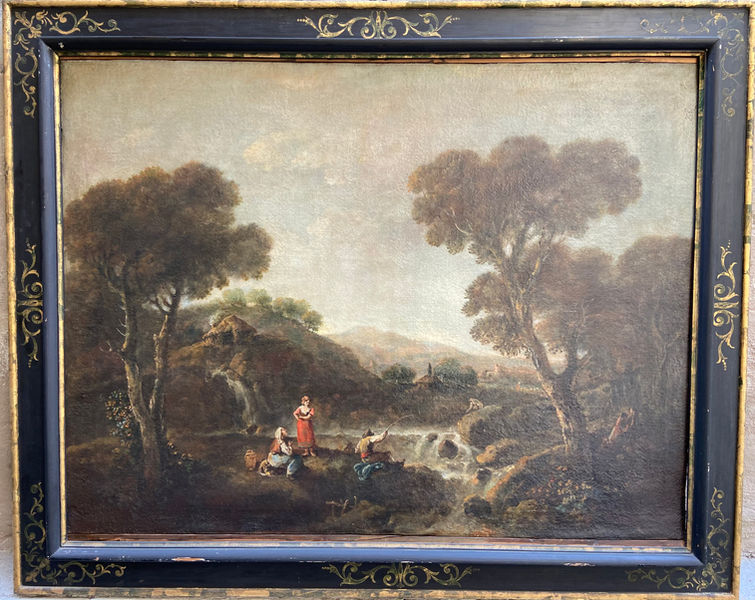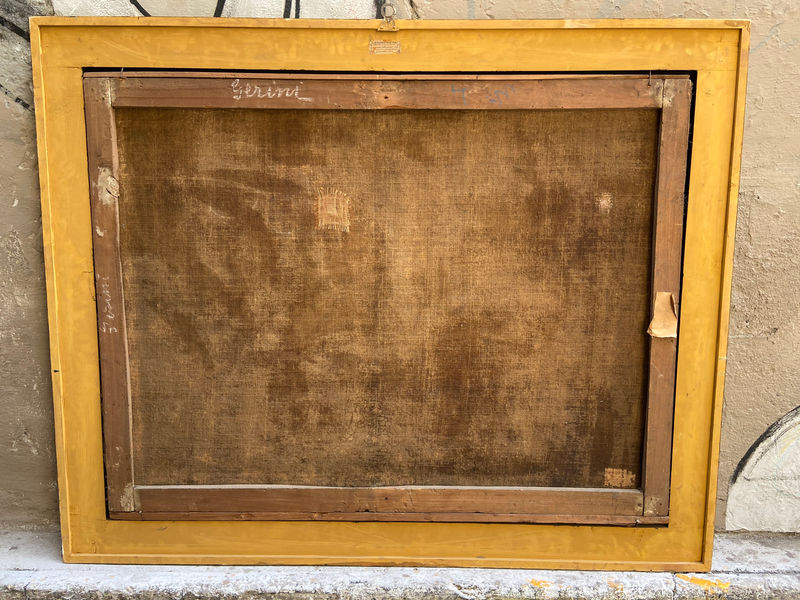
School of Giuseppe Zais (Forno di Canale, 1709 - Treviso, 1781)
Paesaggio Veneto del Settecento
Oil on canvas
Size: 110cm x 133cm (frame)
This eighteenth-century Venetian landscape is monumental. Stretching 1.10 metres high and 1.33 metres across, it can easily fill an entire wall in the gallery. And yet, the individual elements of the painting are meticulously rendered: heavy, swift brushstrokes shape the streaming foam around the rocks and down the river whilst airy, thin paint infuses the foliage in the leaves. There is a carefully balanced, aestheticised arrangement of nature: two grand, framing trees dwarf a central group of three rustic figures - a peasant woman, a fisherman, and a seated figure - in an open clearing in the surrounding woods. These anonymous figures (staffage) are typical of the Arcadian landscape as man harmoniously exists with nature in an aesthetic whole. The vision of nature here is self-consciously 'artistic'; this is a pastoral world suffused with a charming, idyllic atmosphere.
The picture shares that thin wash of light (in the muted clouds to the gentle shades of the wood) distinctive to the veduti (landscapes) from the eighteenth-century Veneto, epitomised by Venetian masters such as Marco Ricci (Belluno, 1676 - Venice, 1730) and Francesco Zuccarelli (Pitigliano, 1702 - Florence, 1788). But the thick, wiry brushstrokes (moving up the tree trunks, down the cascading stream) are more typical of the latter half of the eighteenth century. The picture has many stylistic similarities with the work of Giuseppe Zais (Forno di Canale, 1709 - Treviso, 1781), another landscape painter active in Venice in the later-eighteenth century. The colourfully-dressed, peasant figures (especially the yellow-vested fisherman) - rendered with only a few, quick brushstrokes - look distinctively familiar (c.f. Zais's Landscape with a Ruined Tower in the National Gallery or his Italianate Wooded Landscape in the Bridport Museum). This use of quick, controlled brushwork and impasto lends the painting an especially decorative and affected texture.
Provenance and Condition:
The landscape, in its period frame, is in excellent condition. The picture also has an interesting provenance. From the Florentine dealer's information as well as the 'Gerini' chalk marking on the back of the stretcher, the painting can be traced back to the Villa Gerini in the Tuscan hills to the North of Florence. This Villa dates back to the fourteenth century and has been home to prominent Italian noble families: from the Cappelli family until 1654, to the del Benino family until 1860, and finally passing on to the Gerini family. The Gerini owners are also connected to Pope Pius XII (1876-1958) from the Pacelli family. Upon the death of the Marquis Piero Gerini in 1939, the Villa passed to his wife, the Marquess Maria Teressa Pacelli, who was the cousin of the late Pacelli Pope. The Pope is even recorded to have visited the Villa (albeit when he was still a Cardinal) in 1938 for the Gerini-Dufour Berté wedding.
The presence of the painting in the Gerini collection accounts for its virtually untouched condition: the picture is on its original canvas and stretcher and has undergone almost no restoration. Its beautiful, eighteenth-century frame is likely the picture's original. The landscape was probably bought by one of the eminent Gerini collectors in the nineteenth or early-twentieth centuries and left hanging in place in the Villa undisturbed. The picture's distinguished provenance confirms its status as a fine, original work of eighteenth-century Venetian landscape.

